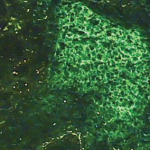Current scientific evidence suggests that B-cell-targeted therapies may be considered in patients with systemic Sjögren’s, especially in those who are refractory to traditional approach (lack of response or intolerance to corticosteroids and immunosuppressive agents). The amount and quality of evidence on the off-label use of these drugs (overwhelmingly rituximab) in SS-related extraglandular features is higher than that reported for the use of the standard options (corticosteroids and immunosuppressive agents). Several studies have recently evaluated the use of rituximab in pSS patients. Gottenberg et al15 studied the use of rituximab in systemic Sjögren’s and found an overall efficacy of 60%, while Carubbi et al16 found a more-pronounced ESSDAI reduction than in those treated with conventional therapy. In contrast, the efficacy of rituximab in the most prominent triad of symptoms (dryness, fatigue and pain) is not clear.17,18 Because several studies have supported a role for BLyS in the pathogenesis of pSS, inhibiting BLyS may be an attractive therapeutic approach. A recent study found that 18 (60%) out of 30 patients with active pSS who were treated with belimumab showed clinical improvement and significant reduction of the ESSDAI score.19
Not All Patients Require the Same Follow-Up
Patients with disease limited to mucosal surfaces may require only annual evaluation, while those with systemic disease should be evaluated by the specialist in autoimmune diseases at least every six months and those with end-organ damage at least every three months.1 Routine physical examination should include examination for peripheral lymphadenopathy and enlargement of parotid/submandibular glands, the liver and the spleen. Yearly laboratory tests should include full blood count, ESR, and renal and liver function tests. Immunological tests are not necessary in routine follow-up except for markers associated with a poor prognosis (e.g., complement levels, cryoglobulins, monoclonal gammopathy) and in patients with a clinical suspicion of the development of a concomitant systemic autoimmune disease.
Current scientific evidence suggests that B-cell-targeted therapies may be considered in patients with systemic Sjögren’s.
A careful workup in differentiating systemic Sjögren’s from other systemic and autoimmune diseases is mandatory for some specific systemic presentations that are found very infrequently in pSS. These include erosive arthritis, extracutaneous noncryoglobulinemic vasculitis, pericarditis and pleurisy, pancreatitis or proximal renal tubular acidosis, among others. In these patients, specific autoantibodies related to other systemic autoimmune diseases should be provided for the majority of systemic involvements (i.e., negativity will confirm “primary” SS in these patients).
Future Directions
The clinical approach of patients with pSS has traditionally focused on the study and characterization of glandular involvement, even though pSS is undeniably more than a sicca disease. In fact, pSS is still diagnosed (i.e., classified) using criteria exclusively focused on glandular involvement, and this occurs despite the fact that a long list of extraglandular features involving the majority of organs and systems has been reported over the past 30 years. From a practical point of view, diagnostic decision making of systemic Sjögren’s is not standardized and is based on the specific clinical experience of each group—often based on the experience of other diseases, such as lupus or systemic vasculitis—together with expert opinion.


